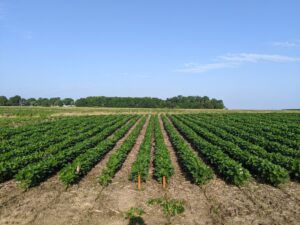Illinois Crop Update 7/22/2022
Each week, I put out a request to crops educators and specialists from the University of Illinois to compile an update to share with the entire state. We hope you find this information useful. If you have any questions or suggestions about the format or any feedback in general about these updates, please email me (harbach2@illinois.edu).
Nick Seiter, University of Illinois Field Crop Insects Extension Specialist
I received a report of spraying for spider mites in an area of northeastern Illinois that has missed much of the recent rains; be sure to scout areas that remain drought-stressed for an extended period of time, and avoid unnecessary broad-spectrum insecticides under these conditions.
Trent Ford, Illinois State Climatologist, Illinois State Water Survey
Temperatures this past week in Illinois ranged from the mid-70s to mid-80s, between 1 and 2 degrees above normal. July to date has been within 1 degree of normal in most of northern and central Illinois, and 1-2 degrees warmer than normal in southern Illinois. Carbondale has had 8 days so far this year with a nighttime low temperature above 75 degrees, tied with 1980 and 1934 for the second most on their 120-year record.
Many places got beneficial rain last weekend, and areas in Winnebago, Boone, Clay, and Effingham Counties picked up between 3 and 5 inches. Unfortunately, the driest part of the state got much less, with parts of Piatt, Champaign, and Vermilion Counties picking up less than 0.5” total. The US Drought Monitor improved a lot of drought area in this week’s map in response to the weekend’s rain but also kept severe drought in east-central Illinois and moderate drought in parts of northeast and far southern Illinois.
Looking ahead, following a hot and mostly dry weekend, chances of precipitation increase as we move into next week. 7-day forecasted totals are between 1.5 and 3 inches statewide. The additional rain will be much welcome as crops continue to progress toward or into reproductive stages. Farther, out, the outlook for the first week of August also leans wetter and warmer than normal, providing some hope for a wetter start to the final month of summer. However, the outlook for the entire month of August leans drier than normal, so we’ll want to make the most out of the rain we get over the next 2-3 weeks.
Talon Becker, Commercial Agriculture Extension Educator, South-central IL
Most of the southern Illinois region received at least an inch of rain this past weekend, with higher totals in the northern parts of the region. The much-needed rain has helped to bring soil moisture back closer to normal, although hot temperatures this week and with many corn and soy field entering into reproductive growth, that soil moisture is quickly being depleted once again. Hopefully, the scattered chances of rain in the forecast for next week will materialize into something substantial enough to keep soil moisture sufficient.

Nathan Johanning, Commercial Agriculture Extension Educator, Southwestern IL
Crops are holding their own for the amount of heat and dry weather that we have had. Double crop soybeans had enough rain to get going but are starting to show some stress now. Despite high hopes for a “saving rain” last weekend most of the area locally missed any significant rainfall. I heard reports of 0.2″ to 0.5″ last weekend, but you don’t have to go much further south into Randolph Co. to hear reports of over 2″. We are predicted to have high in the upper 90s to low 100s through the weekend. Hopefully, the heat and humidity will drum up some more much needed rainfall for the area.
Phillip Alberti, Commercial Agriculture Extension Educator, Northern IL
Despite dry conditions throughout June, weekly meaningful accumulations have been a welcome sight in NW Illinois to help make up the moisture deficit. Continued warm temperatures coupled with regular precipitation have improved crop condition and bouyed development. As we head into the final days of July, soybeans (R1) are flowering and corn (V10-R1) is silking in many fields.
Chelsea Harbach, Commercial Agriculture Extension Educator, Northwestern IL
We received a touch of rain last Friday, and it has been dry since. Hot and dry. But the water reserves in the ground must be sufficient because crops are showing no symptoms of drought stress. I looked at the forecast this morning and have to admit my surprise at the 10-day forecast- cooler and wetter weather. Generally, this is a recipe for disease. So a week ago or so, my guess was that we were going to have a very boring year for disease (from a plant pathologist’s standpoint). But after looking at the forecast, we might have something to look at, AND it appears that maybe all of those fungicide applications that went out the last couple of weeks might have been very timely in a prophylactic sense for disease mitigation. It will be important to continue scouting for diseases to have an understanding of how your different disease management measures are affecting disease development in your fields.





